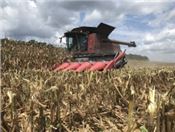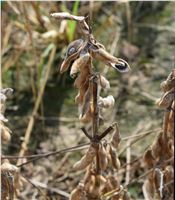|
Farm Bill Mostly Beneficial For Louisiana Ag Producers

Chad Evans, a corn producer in Catahoula Parish, harvests an experimental verification cornfield near Harrisonburg. Corn yields for the state averaged 170 bushels per acre in 2018, down 14 bushels from last year. A new farm bill was passed Dec. 12, and it has some provisions that will be beneficial to Louisiana farmers.
Photo by Craig Gautreaux/LSU AgCenter
BATON ROUGE, LA.
Both the U.S. Senate and House of Representatives passed the 2018 farm bill with strong bipartisan support. The bill passed the Senate on an 87-13 vote and passed the House by a vote of 386-47. This is the first time since 1990 that a farm bill has been enacted the same year it was introduced.
Michael Deliberto, an agricultural economist for the LSU AgCenter, said the 2018 farm bill is “more an evolution of farm policy and not a revolution.” His interpretation of the bill is it is in line with a continuation of the previous farm bill and does not make any radical changes.
Deliberto said factors that shaped the 2018 version were lower commodity prices for the past few years, political realities and constraints being placed on the federal budget by Congress.
“There were some changes to Title I programs that should be beneficial to Louisiana farmers during tough times,” Deliberto said.
According to U.S. Department of Agriculture data, these are tough times. Net farm income is projected to drop 12 percent in 2018, the lowest levels since 2002. Poor market conditions, especially for Louisiana soybean producers, and adverse weather have played havoc on farmers.
Deliberto said some of the most notable changes were done to appeal to the interests of the nonfarm voting bloc.
“This farm bill does maintain and enhance the crop insurance programs, which are helpful to growers. It also expands most conservation programs and creates new assistance to indoor and urban agriculture. The bill also increases aid to organic agriculture and farms that serve local markets,” Deliberto said.
One of the most significant changes to both the Agriculture Risk Coverage (ARC) and Price Loss Coverage (PLC) programs is, starting in 2021, producers will be allowed to make annual elections rather than five-year decisions under the 2014 farm bill.
This annual decision component will give producers more flexibility to respond to changing market conditions.
The individual payment limit remains at $125,000, but the definition of family was extended in the 2018 version to include nieces, nephews and first cousins.
“For the ARC program, payments will now be calculated based on the physical location of the farm, not the administrative parish location,” Deliberto said. “Another change to ARC is USDA Risk Management Agency yields will be used as the first source of parish-level yield information. These acres are documented and certified and will be used to set revenue guarantees and calculate payments.”
Deliberto said the new farm bill increased acreage in the Conservation Reserve Program, which is good for Louisiana. The CRP cap will be increased from the current 24 million acres to 27 million acres by 2023.
“While acres allocated for CRP will go up, there is a slight decrease in rental rates for this program,” he said. “The new bill also encourages the use of cover crops for conservation purposes. Producers may want to examine the provisions related to cover crops.”
President Donald Trump has indicated that he plans to sign the bill. ∆

Damaged soybeans are present in the pods in a field yet to be harvested. A change in the 2018 farm bill will allow
producers to make annual elections concerning their crops rather than to five-year commitments as required by the previous bill.
This change will give farmers more flexibility to adapt to changing market conditions for agricultural commodities.
Photo by Todd Spivey/LSU AgCenter
|
|